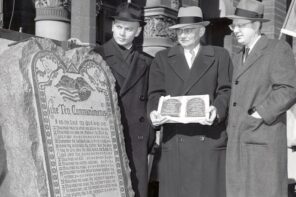Religions are richly variable in their organizations, belief systems, rituals, and practices. This is true across cultures and history. Grand statements about what “all religions” say or believe about anything—especially about such a complex phenomenon as human desire and sexuality—are not just unhelpful, they’re impossible. Nonetheless, this has not prevented many Christian opponents of homosexuality from asserting that all religions condemn homosexuality. This assertion is patently false; it is not even the case that all Christianities condemn homosexuality. The myth that all religions condemn homosexuality passes off one strand of Christian interpretation as a universal moral claim about what “all religions” and “all religious people” believe. In fact, what religions have to say about homosexuality varies considerably not just among religions, but within religions, too.
Religions are internally diverse. Although we are used to referring to Christianity, Hinduism, Judaism, Islam, or Buddhism in the singular, we could more accurately refer to these dynamic ways of organizing human relationships in the plural: as Christianities, Hinduisms, Judaisms, Islams, Buddhisms. This shift from singular to plural may sound odd, but is helpful when it reminds us that no religion is monolithic. What any religion means in the lives of its practitioners changes across historical periods, geographical locations, and in relation to other social forces.
We can see this clearly in the case of Hinduism’s complex and changing attitudes toward homosexuality. Same-sex attachments and desire were both known and generally tolerated in ancient and medieval India, as reflected in such sacred texts as the Kama Sutra and Krittivasa Ramayana. It was not until India came under British colonial rule—with its Christian assumptions about sex—that Section 377, the first Indian law banning “carnal intercourse against the order of nature,” was passed, in 1860. The efforts of modern-day Indian activists—both Hindu and non-Hindu—for sexual rights finally led to the overturning of Section 377, in 2009.
A religion is not practiced in a vacuum. It lives and breathes through individuals and the communities they build in particular times and places. This living, breathing religion does not stand apart from larger political struggles, but is embedded in them in complicated ways, as the above history of Hinduism and homosexuality shows.
Value judgments—what we might also call morality—are not monopolized by religion. You do not have to be religious to live morally. All people are capable of making value judgments and acting in relation to others in accord with deeply held ethical principles—and they do, in big and small ways every day. But in the United States, due to the historical importance of Christian thinking, there is a strong tendency to conflate religion and values. Many Americans believe that the only way to have values and be moral is to be religious, and then, only in a Christian way. This is not how the terms “morality” or “values” are being used here, however.
Buddhism offers an important counter to the usual ways of framing this issue as a matter of the morality of heterosexuality versus the immorality of homosexuality. In both branches of Buddhism, Theravada and Mahayana (which houses both Zen and Tibetan schools), the key distinction is not between good heterosexuality and bad homosexuality, but between celibacy and sexuality. Celibacy is the religious ideal, but Buddhism recognizes that very few people can achieve it. For laypersons, the goal is to avoid sexual misconduct. Buddhist rejections of same-sex desire and sexual activity are relatively rare, but, where they do occur, they must be understood as part of a more general suspicion of any expression of carnal desire. More generally, Buddhist moral appraisal of homosexuality varies with its host cultures. In places that are more accepting of homosexuality and gender variance, same-sex desire is more likely to be seen as a permissible and potentially correct conduct.
When a religion does condemn homosexuality, what is it condemning? Is it same-sex sexual acts and, if so, which ones? Or is it homosexual identity? Or both?
Consider what the Bible has to say about homosexuality. The short answer is: not much. The longer answer requires understanding that sacred texts are given meaning through interpretation; these interpretations change over time and can also vary within any particular period. The Hebrew Bible—what Christians call the Old Testament—does mention and condemn same-sex sexual behavior, but only three times, twice in Leviticus (18:22 and 20:13) and once in Genesis (19:1–11), in the story of Sodom and Gomorrah. In the New Testament, homosexual acts might be mentioned, depending on the interpretation, in Paul’s letter to the Romans condemning men’s “shameless” sexual acts with each other (just which acts are not named) and in his condemnation of women’s “unnatural” sexual acts (1:26–27).
Biblical and Talmudic scholars, as well as historians specializing in the study of premodern Christianity, have convincingly argued that these passages do not condemn homosexuality as we think of it today. The Hebrew Bible and the New Testament had no concept of homosexuality as a personal identity. These few Biblical passages focused on sexual behavior. Scholars have worked hard to determine what these passages and their exact words meant in their day, and for ours. Some of the results are surprising. What are these passages so worried about if it is not the idea of a homosexual person or a personal identity?
Contemporary scholars argue that the moral transgression of Sodom was not male-male sexual relations, but the gross abuse of guests. The men of Sodom came to Lot’s door and demanded that he hand over his two male houseguests (angels in disguise) so they could forcibly “know” them. In Biblical language, “know” means to have sex with. So the Sodom story is about the threat of rape and the violation of laws of hospitality to strangers—a very important issue for a nomadic people.
Lot is also an honored figure in Islam’s holy book, the Quran, where the story of Lot’s people and the destruction of Sodom appears five times. Islamic commentaries from the medieval period show a diversity of scholarly and legal views about the precise “sin” of Sodom, although the interpretation that became dominant identifies it with male-male anal sex. Under Sharia, or Islamic law, same-sex sexual acts were early on condemned, especially anal sex between men. But Islamic jurists have disagreed both historically and today as to what the proper penalty for male homosexual acts should be. Historically, sex between women seems to have attracted far less commentary by either medieval or contemporary jurists, and little in the way of mandated penalties.
In the twentieth century, various Islamic revivalist movements, particularly within Sunni Islam, seeking to be traditional or authentic have tended to call for the death penalty for male homosexual acts. They claim this is the Islamic position. This obscures historical as well as contemporary differences of interpretation within Islam and across very different Muslim-majority countries. Still, the death penalty is on the books (if rarely meted out) as a possible punishment for male homosexuality in several countries, including Iran and Saudi Arabia. In early 2012, a Shiite militia group in Iraq—where homosexuality is not illegal—tortured and murdered more than forty men thought to be homosexual. The murders were denounced by Iraqi human rights groups as well as by international LGBT activists. The Iraqi government did not condemn or even address the murders.
All this may seem shocking, but, sadly, the criminalization and severe legal punishment of homosexuality are hardly unique to countries that follow Islamic law. In contemporary Uganda, legislators influenced by the most conservative versions of evangelical Christianity, especially versions imported from the United States, have been debating making homosexual sex a capital crime. (Homo-sexual acts are already against the law in Uganda.) And Russia’s government, looking to shore up its popularity, increasingly embraces the antigay theology of the Russian Orthodox Church by cracking down on LGBT people, especially activists.
In recent years, the interpretation of the story of Sodom and Gomorrah as a condemnation of rape and inhospitality has been taken up by contemporary LGBT Muslim groups, such as Toronto-based Salaam and US-based Al-Fatiha, and by a growing number of Muslim scholars in order to push back against the most conservative Islamic voices and open a space for Muslim gender and sexual minorities. The Internet also provides a vital resource for LGBT Muslims seeking to develop and put forward their own religious perspectives about same-sex desires and identities.
Where Leviticus is concerned, only anal sex between men is explicitly condemned. Notably, the Hebrew Bible is completely silent on the question of lesbianism. Talmudic scholar Daniel Boyarin suggests that Leviticus’s prohibition on male-male anal intercourse actually concerns a “mixing of kinds.” A man who lets himself be penetrated by another man takes the subordinate position assigned to women. In so doing, he violates rules of manhood, “mixing” or confusing his proper status. Leviticus’s prohibition, then, like the story of Sodom, warns against the transgression of social codes that ensure an ordered society. Being penetrated by another man, or raping two male houseguests, is a metaphor for disorder and the neglect of social constraint. Such a scenario may seem extreme for the lesson it imparts, but that is how allegories teach us moral lessons.
Historically, the most frequently cited scriptural passages in all three Abrahamic traditions—Judaism, Christianity, and Islam—provide little convincing evidence to justify legal or social discrimination against LGBT people. What the Bible does or does not really say about homosexuality is less the point than how living, breathing historical people organize meanings and judgments around sexual activity and how we think about our bodies.
What of Christianity, the dominant religion in the United States? A large majority of Americans identify as Christian, and even non-Christians may find themselves holding “Christian” ideas about sex and proper and improper uses of the body. Additionally, whether you are Christian or not, in the United States you will be subject to laws that are directly influenced by Christianity’s historical ambivalence about, and even fear of, the body and sex. A dominant line of Christian theology has identified the “lusts of the flesh” with human fallenness—sometimes called “original sin”—and seen sex and the body as places where humans are especially liable to exhibit possessiveness, greed, and corruption. A lesser tradition within Christian theology seeks to affirm the body. In the United States, Christian ambivalence toward sexuality and the body has been handed down through Protestant theology. Elsewhere in the Americas, and in much of continental Europe, there is a similar, but specifically Catholic theology surrounding the body and sexuality.
Whether affirming or warning against sex, moral teaching is as much about prescriptions for how to live peacefully and productively with others as it is about prohibitions. These principles are often informed by and learned through religious morality. But you do not have to be religious to agree that treating your neighbor with respect and dignity is a good thing. The very concept of separation of church and state reinforces the idea that moral rules and ethical practices do not have to be tied to religion at all. These common principles do not require that we all agree. They are the social context in which we can peacefully disagree and morally engage with one another despite our many differences (see myth 11, “Gay Rights Infringe on Religious Liberty”).
In public discussions of homosexuality and same-sex marriage, many self-identified religious people openly disagree with the official positions of their religious leaders. For example, a strong majority of lay Catholics support antidiscrimination laws and even same-sex marriage or civil unions. A March 2011 report by the Public Religion Research Institute found that “nearly three-quarters of Catholics favor either allowing gay and lesbian people to marry (43%) or allowing them to form civil unions (31%). Only 22% of Catholics say there should be no legal recognition of a gay couple’s relationship.” A growing number of mainline Protestants and evangelicals also support some form of legal recognition of same-sex relationships. This is especially true for Christians between the ages of eighteen and thirty-four. There is often a wide gap between the pronouncements of religious leaders and the values held by individuals who have, in their own conscience, and in the context of shared social life, made their own decisions about the morality of homosexuality.
Some religious traditions openly welcome LGBT members and will sanctify same-sex unions. There is even an evangelical Christian ministry dedicated primarily to LGBT people, the Metropolitan Community Church, founded in 1968 by Reverend Troy Perry. (Perry, originally a Pentecostal minister, was defrocked for his homosexuality.) Nevertheless, the public debate over LGBT rights and same-sex marriage has overwhelmingly pitted religious values against civil equality. This ignores the reality that equality is also a moral—and, for many, a religious—value. This polarizing debate leaves out the great diversity of perspectives many religious people hold on same-sex marriage and other issues regarding sexual behavior. Just because you’re religious does not mean you are against either homosexuality or same-sex marriage on religious grounds. Again, you might support it on religious grounds.
Two mainline Protestant denominations recognize and perform same-sex marriages: the United Church of Christ and Unitarian Universalists. Several others—the Presbyterian Church (USA), the Evangelical Lutheran Church in America, and, most recently, the Episcopal Church—allow individual congregations to support and bless same-sex unions. Within Judaism, both the Reform and Reconstructionist Jewish movements support same-sex marriage and permit individual rabbis to officiate at same-sex weddings. The Conservative movement also allows individual rabbis to bless same-sex unions, but has so far stopped short of endorsing same-sex marriage.
Despite this great diversity of religious attitudes toward homosexuality and same-sex marriage, many people believe that debates over religion and sexuality irrevocably mean taking one of two opposed sides. Some people argue that sexuality must be limited, or controlled, by morality—in the form of religion—for the good of an ordered society. Others counter that sexuality needs to be freed from the repressive constraints of religion.
Ironically, both opponents and supporters of LGBT equality believe in this supposedly uncrossable divide between religion and sexuality. Versions of this argument are so frequently repeated by media commentators, politicians, and activists that they have become common sense. This is not just about homosexuality. In reporting on a range of issues related to sexual life—such as birth control, “out-of-wedlock” births, abortion, homosexuality, and even sexual assault—the US media overwhelmingly quote the most conservative religious perspectives as the moral position on an issue. This means that conservative Christians, usually evangelical or Catholic, get the most airtime. Is it any wonder, then, that many LGBT people and feminists identify religion as “the enemy”?
Blanket proclamations such as “religion is the enemy” overlook the many self-identified feminists and LGBT people who are religious and who do not think they should have to choose between their sexuality and their religion. For these LGBT people and their allies, it would be simplistic, and arrogant, to condemn religion as “the enemy.” This equation implies that all religions and all religious people are universally hostile to homosexuality. This is exactly what religious conservatives want us to believe: that all religions condemn homosexuality.
This false choice misses another major point. Respect between people of different sexualities, and even within individual relationships, can make sexuality and desire productive forces in society. Sexual intimacies are a form of human relating. They often are the basis for creating moral ways to imagine and make lives with other people. This does not mean that every time you have sex, you have a moral breakthrough. It does mean that sex has the capacity to help us forge deep ties and knit larger communities, a primary purpose of many religions. An example of this is how, in the early years of the AIDS crisis in the 1980s, gay men were able to come together to confront the crisis when the US government did not. By drawing on already-developed sexual networks and institutions, such as bars and clubs, gay men were able to care for the sick, start educating one another about HIV/AIDS, and save their own lives. Gay men created not just political alliances, but alternate forms of kinship, out of their ways of relating to each other sexually. Lesbians have done this as well.
Religious people continue to struggle within their communities to integrate their understanding of their traditions with the realities of the LGBT people in their midst as neighbors, family members, and fellow congregants. For many religiously active LGBT people and their allies, it may make sense to engage in debates with religious conservatives about how to interpret particular religious texts or implement traditions. Such debates are already taking place within many religious communities.
Both religion and sexuality are ways of living—in the language of the US Constitution, forms of “free exercise”—that are essential to, and even define, personal identities. Ways of living are informed by practices as well as by a sense of an inner life. With religion, the inner life is often called conscience. With sexuality, the inner life is the feeling of desire. In both cases, these are profound, lived experiences that make themselves known through practices. Many people “know” what they believe, and many people “know” what and whom they desire, by enacting these beliefs with others. These experiences and feelings keenly inform how individuals understand their lives and make commitments to others. Sexuality and religion may have a lot more in common than most people imagine. Neither has to be discarded or cast out to make room for the other. They can, in fact, be understood through each other.




